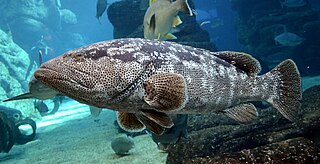
The Malabar danio is a tropical fish belonging to the minnow family (Cyprinidae). Originating in Sri Lanka and the west coast of India, the fish has been circulated throughout the world through the aquarium fish trade. It grows to a maximum length of 6 in (15 cm) rarely exceeds 4 in (10 cm) in a home aquarium.

Francis Talbot Day was an army surgeon and naturalist in the Madras Presidency who later became the Inspector-General of Fisheries in India and Burma. A pioneer ichthyologist, he described more than three hundred fishes in the two-volume work on The Fishes of India. He also wrote the fish volumes of the Fauna of British India series. He was also responsible for the introduction of trout into the Nilgiri hills, for which he received a medal from the French Societe d'Acclimatation. Many of his fish specimens are distributed across museums with only a small fraction deposited in the British Museum, an anomaly caused by a prolonged conflict with Albert Günther, the keeper of zoology there.

The Malabar grouper also known as blackspot rockcod, estuary rockcod, giant rock cod, greasy grouper, Malabar rockcod, Morgan's cod or speckled grouper, is a species of marine ray-finned fish, a grouper from the subfamily Epinephelinae which is part of the family Serranidae, which also includes the anthias and sea basses. It is found in the Indo-Pacific region. It has entered the Mediterranean Sea from the Red Sea by way of the Suez Canal as a Lessepsian migrant.

Arius is a genus of catfishes of the family Ariidae. The genus Arius is distributed in brackish and fresh waters of Eastern Africa and south to Southeast Asia.

The Malabar trevally, also known as the Malabar jack, Malabar kingfish or nakedshield kingfish, is a species of large inshore marine fish of the jack family, Carangidae. It is distributed throughout the Indian and west Pacific Oceans from South Africa in the west to Japan and Australia in the east, inhabiting reefs and sandy bays on the continental shelf. The Malabar trevally is similar to many of the other species in the genus Carangoides, with the number of gill rakers and the grey-brown colour of the tongue being the diagnostic features. The Malabar trevally is a predator, taking a variety of small fish, cephalopods and crustaceans. The species is of minor economic importance throughout its range, caught by a variety of net and handline methods.

The imposter trevally, also known as the imposter jack or white-tongued trevally, is a species of small coastal marine fish in the jack family Carangidae. The imposter trevally is distributed through the tropical waters of Indian and west Pacific oceans, from the Gulf of Oman in the west to Japan and Australia in the east. The species is quite similar to the Malabar trevally, but can be distinguished by its gill raker count, and is identifiable from other species by having a white to pale grey tongue. It is a relatively small species, growing to a maximum recorded length of 30 cm. The imposter trevally inhabits coastal waters of the continental shelf in depths of up to 140 m, often associating with closely related carangid species. It preys on a range of small fish, crustaceans and cephalopods, but little is known of its reproductive biology. The imposter trevally is of minor importance to fisheries throughout its range, taken by hook and line, bottom trawls and several types of artisanal gear.

Porpita porpita, or the blue button, is a marine organism consisting of a colony of hydroids found in the warmer, tropical and sub-tropical waters of the Pacific, Atlantic, and Indian oceans, as well as the Mediterranean Sea and eastern Arabian Sea. It was first identified by Carl Linnaeus in 1758, under the basionym Medusa porpita. In addition, it is one of the two genera under the suborder Chondrophora, which is a group of cnidarians that also includes Velella. The chondrophores are similar to the better-known siphonophores, which includes the Portuguese man o' war, or Physalia physalis. Although it is superficially similar to a jellyfish, each apparent individual is actually a colony of hydrozoan polyps. The taxonomic class, Hydrozoa, falls under the phylum Cnidaria, which includes anemones, corals, and jellyfish, which explains their similar appearances.

Lutjanus malabaricus, the Malabar blood snapper, saddletail snapper, large-mouthed nannygai, large-mouthed sea-perch, Malabar snapper, nannygai, red bass, red bream, red emperor, red Jew, red snapper, saddletail seaperch, scarlet emperor or scarlet sea-perch, is a species of marine ray-finned fish, a snapper belonging to the family Lutjanidae. It is native to the Indian Ocean and the western Pacific, where it is found east to Fiji and Japan.

The threadfin sea catfish, also called the Hamilton's catfish, marine catfish or jella, is a species of sea catfish in the family Ariidae. It was described by Francis Buchanan-Hamilton in 1822, originally under the genus Pimelodus. It is migratory and is found in tropical brackish and marine waters in the Indo-western Pacific region, including Bangladesh, India, Cambodia, Malaysia, the Philippines, Pakistan, Sri Lanka, Myanmar, Hong Kong, Thailand, Singapore, and China. It reaches a maximum standard length of 40 cm (16 in), but more commonly reaches an SL of 15 cm (5.9 in).
The Rough-head sea catfish, also known as the marine catfish is a species of sea catfish in the family Ariidae. It was described by Albert Günther in 1864. It inhabits tropical marine and brackish waters in the eastern Atlantic region, including Angola, Senegal, and Bioko. It dwells at a depth range of 0 to 70 m, most often between 0 to 30 m. It reaches a maximum total length of 85 cm (33 in), but more commonly reaches a TL of 40 cm (16 in).
The spotted sea catfish, also known as the spotted catfish, the sea barbel or the marine catfish, is a species of sea catfish in the family Ariidae. It was described by Carl Peter Thunberg in 1792, originally under the genus Silurus. It inhabits tropical marine, brackish and freshwater in the Indo-western Pacific region, including Bangladesh, India, Pakistan, Myanmar and Sri Lanka. It dwells at a depth range of 50 to 100 m. It reaches a maximum total length of 80 cm (31 in), more commonly reaching a TL of 30 cm (12 in).
The squirrelheaded catfish is a species of sea catfish in the family Ariidae. It was described by Pieter Bleeker in 1855. It inhabits tropical marine and brackish waters in the western Pacific region, including eastern Thailand and Borneo. It reaches a maximum total length of 60 cm (24 in).

The shovelnose sea catfish, also called the short-nosed catfish or the marine catfish, is a species of sea catfish in the family Ariidae. It was described by Achille Valenciennes in 1840.
The goat catfish, also called the marine catfish, is a species of sea catfish in the family Ariidae. Although the author of the species is uncertain, its description has been attributed to Edward Turner Bennett, in 1830. It was originally assigned to the genus Bagrus. It inhabits tropical marine and brackish waters in the Indo-western Pacific region, including eastern Thailand, the Philippines, Pakistan and Indonesia. It reaches a maximum total length of 32 cm (13 in), more commonly reaching a TL of 12 cm (4.7 in).

The veined catfish, also known as the marine catfish, is a species of sea catfish in the family Ariidae. It was described by Achille Valenciennes in 1840. It inhabits tropical marine and brackish waters in the Indo-western Pacific region, including the Mozambique Channel, Myanmar, Indonesia and southern China. It dwells at a depth range of 20 to 50 m. It reaches a maximum total length of 30 cm (12 in), but more commonly reaches a TL of 19 cm (7.5 in).
The Guinean sea catfish, also known as the marine catfish, is a species of sea catfish in the family Ariidae. It was described by Albert Günther in 1864, originally under the genus Arius. It is a tropical fish which is found in the eastern Atlantic off Mauritania, Angola, Morocco and Western Sahara. A single record was reported in the eastern Mediterranean Sea in 1986. It inhabits coastal marine waters at a depth range of 50 to 80 m, also frequently entering estuaries and freshwater rivers. It reaches a maximum total length of 70 cm (28 in), more commonly reaching a TL of 40 cm (16 in).

Nemapteryx caelata, the engraved catfish or engraved sea catfish, is a species of catfish in the family Ariidae. It was described by Achille Valenciennes in 1840, originally under the genus Arius. It inhabits marine and brackish waters in Bangladesh, India, Myanmar, Pakistan, Sri Lanka, and Thailand. It reaches a maximum total length of 45 cm (18 in), more commonly reaching a TL of 24 cm (9.4 in).

The blacktip sea catfish, also known as the Dussumier's catfish, the giant marine cat fish, the Shupanga sea catfish, or the tropical seacatfish, is a species of catfish in the family Ariidae. It was described by Achille Valenciennes in 1840, originally under the genus Arius. It inhabits rivers and marine waters ranging between Africa and India in the Indo-western Pacific. It dwells at a depth range of 20 to 50 m. It reaches a maximum standard length of 62 cm (24 in), and a maximum weight of 1.4 kg (3.1 lb).
The flatmouth sea catfish, also known as the flat-mouthed catfish or the flatmouth catfish, is a species of catfish in the family Ariidae. It was described by Francis Day in 1877, originally under the genus Arius. It inhabits estuaries and coastal marine waters in India, Myanmar, Bangladesh, Sri Lanka, and Pakistan. It dwells at a maximum depth of 50 m (160 ft). It reaches a maximum total length of 31 cm (12 in).
The thinspine sea catfish, also known as the Day's catfish, is a species of catfish in the family Ariidae. It was described by Francis Day in 1866, originally under the genus Arius. It inhabits brackish and coastal marine waters in Mozambique, Sri Lanka, and the Persian Gulf. It dwells at a depth range of 20 to 50 m. It reaches a maximum total length of 36 cm (14 in), more commonly reaching a TL of 23 cm (9.1 in).












